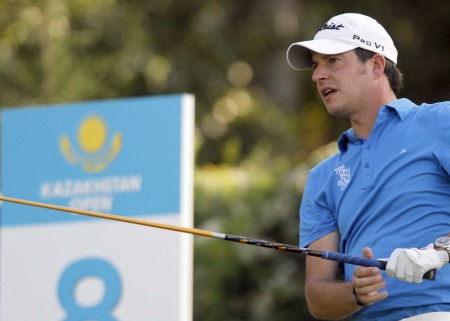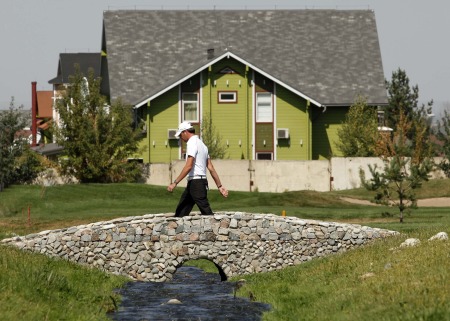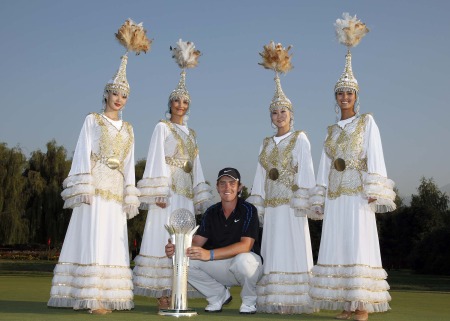Kazakhstan wants more birdies than Borats
Professional golf is often a suffocating world of pampered and petulant stars with its prawn sandwich brigade of blue riband sponsors and elitist venues.
But that world is blown to smithereens when the European Challenge Tour’s twenty-somethings with their iPods, PSPs, Nike caps and insatiable desire to take their game to the next level collide with the youthful enthusiasm of exotic Kazakhstan.
The meeting between the two is akin to Sacha Baron Cohen’s over-the-top Borat wooing Britney Spears: grotesque, bizarre and unbelievable, yet fascinating viewing.
Yet it works in a wonderfully enthusiastic and innocent way. And while Borat tells the Challenge Tour, “You nice!”, he’s really after its bigger, sexier and tantalisingly out-of-reach older sister, the European Tour.
In July, the host club’s head professional Konstantin Lifanov told enthusiastically told Reuters that the Kazakhstan Open would have dual-ranking status with the main tour in 2008 before becoming a fully-fledged $2 million European Tour event in 2009.
Eyebrows were raised by the powers-that-be in Wentworth, who are well aware that Kazakhstan could produce a €5 million sized thud on the table at the drop of a hat. The problem is that the golf course and the logistics are still several years away from being able to take on such a massive project.
As the third edition of the Kazakhstan Open came to an exciting conclusion in front of a sparse crowd at Nurtau Golf Club on Sunday, the Challenge Tour sat down with promoters Parallel Media Group (PMG) and the head of the Kazakhstan Golf Federation in the tiny clubhouse to hammer out the details of a new three-year agreement.
Next year’s event will boast a considerable increase in prize money from this year’s €330,000 and if a new clubhouse is built and major improvements carried out to the course, dual-badge status in not out of the question in the near future.
Alain de Soultrait, the French-born Director of the European Challenge Tour, is hugely enthusiastic about his job and while he lays down the law with an iron-fist, the boys on tour affectionately dub him “Le grand fromage” or big cheese.
“Their ambition is to be on the main tour,” de Soultrait reveals before heading off to clink vodka glasses with the Kazakhstani bosses after the tournament. “We have set criteria for them to meet over the next three years, in 2010 or 2011 and if there is a date available on the main tour, they will be on the main tour.
“Money is not the problem,” he adds, explaining that the golf course, clubhouse and general infrastructure still has a long way to go before making the grade. “But working with them is a pleasure. They have the ambition that typifies the Challenge Tour itself. They really want it. They want the European Tour ASAP. And we are going, ‘Whoah…not too fast.”
While it’s the ninth biggest country on the planet, Kazakhstan has a population the size of Holland’s on a land mass four-times the size of France. Stretching from the vast oil fields of the Caspian Sea in the west to its south-eastern border with China and the imposing Tien Shan Mountains, the cream of Europe’s second tier tour touched down in the former capital Almaty on a charter flight from Amsterdam just over a week ago.
After a painful shuffle through customs and a long wait for golf bags, the vast majority of players pile onto four buses, crossing a city of 1.3 million inhabitants to the gargantuan Alatau Sanitorium .
Situated 10km west of the city, in the shadow of the spectacular Tien Shen Mountains, local taxi drivers still have problems finding this seven-storey, Soviet era concrete monstrosity.
With a top prize of €52,800, it is easily the biggest event of the year and while they mona about the terrible beds, the eerie, 440-yard long corridors, the cell-like yet massive bedrooms and the grey food, they are happy to be here.
The golf course has improved immensely since I visited Nurtau Golf Club for the inaugural Kazakhstan Open won by Dubliner Stephen Browne in 2005. New tees have been built, adding over 200 yards to a track that features two contrasting nines: a mature and wooded back side and a wide-open and somewhat lacklustre front nine.
Bangor’s David Jones, a golf course architect and a member of the European Tour’s board of directors, flies in on Friday to run his eye over the course and suggest how it might be improved.
With five course designs completed in Turkey, he is not surprised by what he finds on his first visit to Kazakhstan and may well be back to help a local gold baron and former rugby player design an ambitious new project on a spectacular site nearby.
“I came over to look at the course on my own behalf and on behalf of the Tour,” Jones tells me over a beer in the basement bar at the Sanitorium, staffed by three of the most intimidating Russian-speaking barmaids you will meet anywhere. “There is ambition in Kazakhstan to take the game forward and move this course forward to initially dual ranking level and hopefully to tour level.
“The basic ingredients for a good golf course are there and the pros generally seem to like it. This is as far as it goes for me. I’ll do up a report and say what things are needed if it is to be considered a venue for a quality event.
“It reminds me of Turkey when I went there first in 1991 and I’ve done five courses there now. There is a lot of ambition, very few golf courses, very little local knowledge and they are looking from expertise from Europe. I was fortunate to get in there at an early stage and it is a really strongly developing golf destination now.
“It is hard to see Kazakhstan as a tourist destination. But the money is there and with so many foreign companies and diplomatic people working there, there is a need and a desire to have golf courses.”
Construction is booming in the ‘City of the Apples’ as this charming and sometimes chaotic city is also known. Floating on a sea of petro-dollars, the are battling to throw off the image of a grim former Soviet Republic and rush headlong into the dream future of their long-time leader Nursultan Nazarbayev.
One ex-pat American at the club tells me that things are changing slowing in a country where GDP per capita is around $9,000. With its vast reserves of oil and gas, the world’s major corporations are well-established in a city that will host the 2011 Asian Winter Games
“A few years ago, a very small proportion of the population controlled 97 percent of the country’s wealth,” he tells me, pulling on a massive cigar. “Not it’s maybe 93 percent. Nazarbayev has promised to share the wealth with the rest of the population, but it’s taking time. A few years ago there was no middle class, now it’s growing slowly.”
Kazakhstan still has a “gold rush” feel to it. Yet while the city of Almaty is bristling with cranes, the neon glow of the once ubiquitous casinos and slot parlours is noticeably absent.
Rich in oil, Kazakhstan, like Russia and some other former Soviet republics, has experienced a gambling boom. In April its 132 casinos and more than 2,000 smaller gambling parlors, slot halls and bookmakers were shut down by presidential decree.
Instead, two massive casino centres will be built with plans to create a Las Vegas of the east at Kapchagai, around 30 km from Almaty and another on the Caspian.
Nazarbayev has said that creating two dedicated gambling centres will help isolate the social cost of gambling from the general population, and also create tourism destinations for foreign gamblers, especially the Chinese.
Kapchagai is located about 640 kilometers, or 400 miles, from the border with China and despite local opposition, the plan is going ahead.
In all, Kazakhstan plans to build six US-style resorts within the next eight years as the Central Asian state seeks to diversify its economy away from energy.
The Disney World and Vegas style entertainment complexes are designed to wean Kazakhstan’s economy off commodity exports and in April, the government unveiled plans to spend $490 million on efforts to double the number of foreign tourists to 9.5 million by 2011.
The resorts in the western Mangistau region will allow Kazakhstan to “conquer a significant portion of the global tourism market, providing serious profit for the budget,” the Tourism Ministry said.
In the movie, Borat: Cultural Learnings of America for Make Benefit Glorious Nation of Kazakhstan, the locals were depicted as bigots, rapists and anti-Semites, while the capital Astana was seen as a backward-looking place boasting a “Funworld” where wives could be left in cages for the day.
The truth is far different and adventurous tourists can enjoy a selection of top class hotels as a vibrant nightlife that easily stands comparison with anything western Europe has to offer.
Judging by the antics of the players who attended the annual, Friday night “Cut Party”, complete with strippers and a “Cocktail” style vodka juggling act, Almaty will soon be a must-see destination of European twenty-somethings with money to spend and testosterone to burn.
For the golfer it is still a backwater. The sports it still in its infancy with just 1,000 golfers - many of them ex-pat American, Japanese and Korean businessmen - and just five golf courses in a country of one million square miles.
Soccer is king in Kazakhstan with wrestling, boxing and cycling a close second.
Almaty has two championship tracks and a pitch and putt course while there are two more courses at Astana, the new capital, on the wind swept steppe that stretches as far as the northern border with Russia a beyond.
But construction is already underway on Jack Nicklaus and Colin Montgomerie designs in the former capital with Jose Maria Olazabal and Jones touted as a possible designers for another top class track.
The host club had just 40 members when the tournament was first held here in 2005 but there are now 250 members, paying a green fee of 500 tenge (€3) for a round of golf on top of an annual subscription of €1,200.
Visitors pay 10,000 tenge for a game - around €60 - which is about half the average monthly wage for the majority of Kazakhstanis.
The head of the local golf federation, Nurtay Abykaev, is well aware what has to be done to attract the main European Tour to Kazakhstan.
“In three years we have moved from purely amateur golf to a more professional approach,” he explains to a packed press conference on the eve of the tournament.
Watching their progress is fascinating. In the immortal words of Borat: I like.





